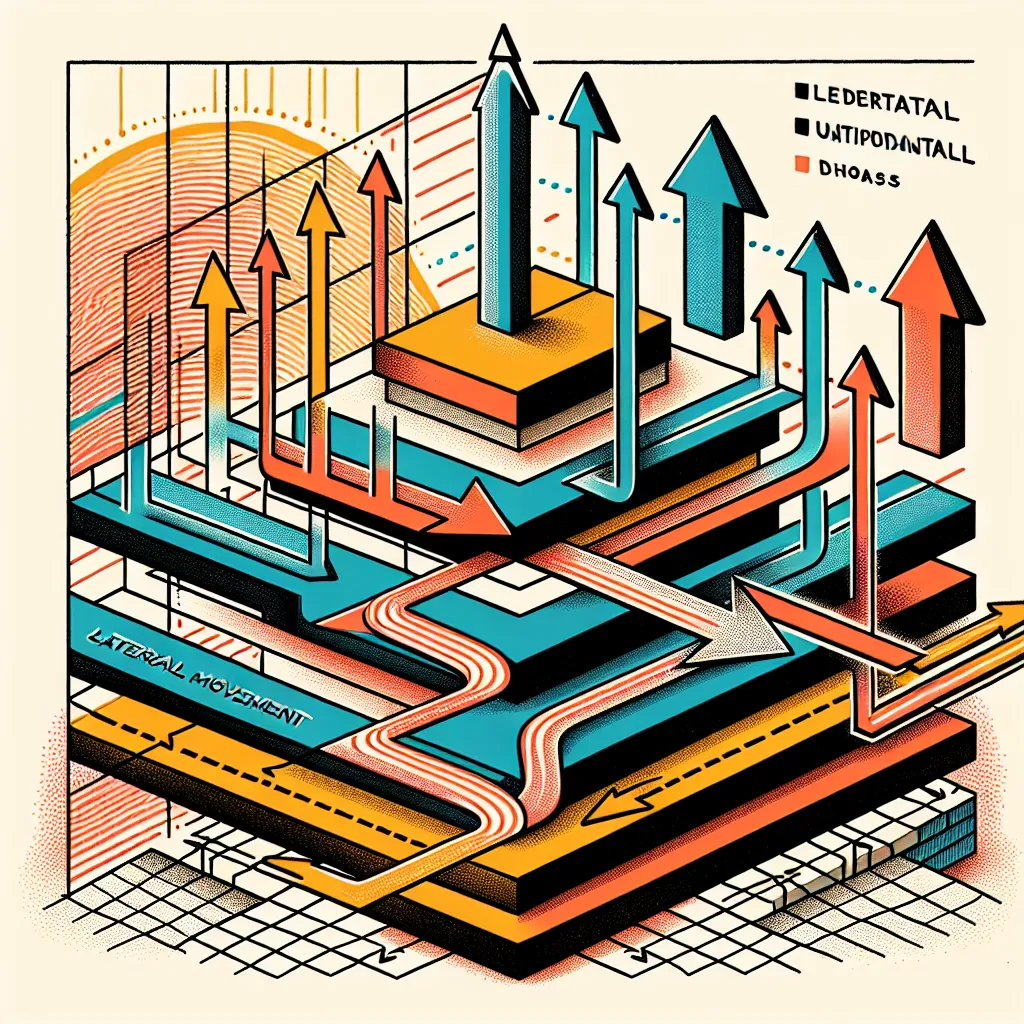Lateral movement is a crucial concept that frequently appears in IELTS exams, particularly in Reading and Writing sections. Understanding this term and its various applications can significantly enhance your performance in the test. Let’s delve into the intricacies of ‘lateral movement’ and explore how to effectively use it in your IELTS preparation.
Definition and Pronunciation
Lateral movement (noun)
Phonetic transcription: /ˈlætərəl ˈmuːvmənt/
Definition: The act of moving sideways or parallel to a given line or plane, often used metaphorically to describe non-linear progress or thinking.

Context and Usage
Examples in Different Contexts
-
Physical movement: “The soccer player’s lateral movement across the field confused the opposing team’s defense.”
Analysis: This example demonstrates the literal use of lateral movement in sports, describing a player’s sideways motion.
-
Career progression: “Instead of seeking a promotion, Sarah opted for lateral movement within the company to gain diverse experience.”
Analysis: Here, lateral movement is used metaphorically to describe a career change that doesn’t involve moving up the hierarchy but rather across different departments.
-
Problem-solving: “The team employed lateral movement in their thinking to approach the challenge from a new perspective.”
Analysis: This example showcases how lateral movement can be applied to cognitive processes, encouraging non-linear or creative thinking.
-
Organizational structure: “The company’s new lateral movement policy allowed employees to easily transfer between departments.”
Analysis: In this context, lateral movement refers to a corporate policy that facilitates horizontal job transfers.
-
Technology: “The cybersecurity team detected suspicious lateral movement across the network, indicating a potential breach.”
Analysis: This usage demonstrates how the term is applied in IT security to describe unauthorized access moving through a network.
Common Contexts
Lateral movement is frequently encountered in discussions about:
- Sports tactics and player movements
- Career development and job transitions
- Creative thinking and problem-solving strategies
- Organizational management and employee development
- Network security and threat detection
Frequency in IELTS
In IELTS exams, ‘lateral movement’ is more likely to appear in Reading passages related to business, technology, or psychology. It may also be a useful term to incorporate in Writing Task 2 essays, particularly when discussing career development or innovative thinking approaches.
Vocabulary Analysis
Word Structure
- Lateral (adjective): relating to the side or sides
- Movement (noun): the act of moving
The combination of these two words creates a compound noun that describes sideways motion or progress.
Synonyms and Antonyms
Synonyms:
- Sideways movement
- Horizontal progression
- Parallel shift
- Cross-functional transfer
Antonyms:
- Vertical movement
- Linear progression
- Hierarchical advancement
- Upward mobility
Memorization Techniques
Mind Mapping
Create a mind map with ‘lateral movement’ at the center, branching out to different contexts:
- Sports → agility, strategy, defense
- Career → skill diversification, job rotation, experience breadth
- Thinking → creativity, innovation, problem-solving
- Organization → flexibility, adaptability, cross-training
Storytelling Technique
Imagine a character named Larry the Lateral Learner. Larry moves sideways through various departments in his company, gathering diverse skills and perspectives. His lateral movement helps him solve a complex problem that stumps his vertically-promoted colleagues.
Practice Exercises
Application in IELTS Writing
Task: Write a paragraph discussing the benefits of lateral movement in career development.
Sample answer:
“In today’s dynamic job market, lateral movement within or between organizations can be as valuable as traditional upward promotions. This horizontal progression allows professionals to acquire a diverse skill set and gain a broader understanding of different business functions. For instance, an accountant moving laterally into a marketing role can develop a unique perspective that combines financial acumen with creative strategy. Such lateral movement not only enhances an individual’s versatility but also increases their value to employers seeking well-rounded team members capable of innovative problem-solving.”
IELTS Reading Practice
Read the following passage and answer the question:
“In the realm of cybersecurity, experts are increasingly concerned about lateral movement within networks. This technique, often employed by hackers, involves moving sideways through a system after gaining initial access. By utilizing lateral movement, intruders can explore and exploit various parts of the network, potentially accessing sensitive data or installing malware across multiple endpoints.”
Question: What is the main concern regarding lateral movement in cybersecurity?
A) It slows down network speeds
B) It allows hackers to explore and exploit different parts of a network
C) It requires advanced programming skills
D) It is easily detectable by standard security measures
Answer: B
Explanation: The passage states that lateral movement allows intruders to “explore and exploit various parts of the network,” which aligns with option B.
Conclusion
Mastering the concept of ‘lateral movement’ can significantly enhance your IELTS performance, particularly in Reading and Writing tasks. Its versatility across various contexts – from physical movement in sports to metaphorical applications in career development and problem-solving – makes it a valuable addition to your vocabulary arsenal.
Remember to practice using this term in different scenarios and to review it periodically to ensure long-term retention. As you prepare for your IELTS exam, consider how you can incorporate ‘lateral movement’ into your essays or use your understanding of the concept to tackle complex reading passages.
For more strategies on enhancing creativity in problem-solving, which is closely related to the idea of lateral thinking, check out our dedicated guide.
We encourage you to share your experiences with using ‘lateral movement’ in your IELTS practice or any questions you might have about this term in the comments section below. Happy studying!